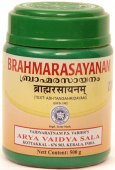Mandukaparni, Maṇḍūkaparṇī, Manduka-parni, Mamdukaparni: 10 definitions
Introduction:
Mandukaparni means something in Hinduism, Sanskrit, biology. If you want to know the exact meaning, history, etymology or English translation of this term then check out the descriptions on this page. Add your comment or reference to a book if you want to contribute to this summary article.
In Hinduism
Ayurveda (science of life)
Dietetics and Culinary Art (such as household cooking)
Source: Shodhganga: Dietetics and culinary art in ancient and medieval IndiaMaṇḍūkaparṇī (मण्डूकपर्णी) refers to a type of vegetable, according to the Suśrutasaṃhitā Sūtrasthāna 46.334, and is commonly found in literature dealing with the topics of dietetics and culinary art, also known as Pākaśāstra or Pākakalā.—Suśruta refers to the vegetable flowers, leaves, fruits, stems and bulbs. Of the pot herbs satīna, vāstuka, cuñcu, cilli, green radish, maṇḍūkaparṇī and jivantī were regarded the best.
Kalpa (Formulas, Drug prescriptions and other Medicinal preparations)
Source: Shodhganga: Edition translation and critical study of yogasarasamgrahaMaṇḍūkaparṇī (मण्डूकपर्णी) refers to the medicinal plant known as “Centella asiatica (Linn.) Urban.” and is dealt with in the 15th-century Yogasārasaṅgraha (Yogasara-saṅgraha) by Vāsudeva: an unpublished Keralite work representing an Ayurvedic compendium of medicinal recipes. The Yogasārasaṃgraha [mentioning maṇḍūkaparṇī] deals with entire recipes in the route of administration, and thus deals with the knowledge of pharmacy (bhaiṣajya-kalpanā) which is a branch of pharmacology (dravyaguṇa).
Nighantu (Synonyms and Characteristics of Drugs and technical terms)
Source: WorldCat: Rāj nighaṇṭuMaṇḍūkaparṇī (मण्डूकपर्णी) is another name for Ādityabhaktā, a medicinal plant, possibly identified with Helianthus annuus Linn. or “common sunflower” from the Asteraceae or “daisy” family of flowering plants, according to verse 4.179-181 of the 13th-century Raj Nighantu or Rājanighaṇṭu. The fourth chapter (śatāhvādi-varga) of this book enumerates eighty varieties of small plants (pṛthu-kṣupa). Together with the names Maṇḍūkaparṇī and Ādityabhaktā, there are a total of eighteen Sanskrit synonyms identified for this plant.
Unclassified Ayurveda definitions
Source: Wisdom Library: Āyurveda and botanyMaṇḍūkaparṇī (मण्डूकपर्णी) is a Sanskrit word referring to Centella asiatica (centella), from the Apiaceae family. Certain plant parts of Maṇḍūkaparṇī are eaten as a vegetable (śāka), according to Caraka in his Carakasaṃhitā sūtrasthāna (chapter 27), a classical Ayurvedic work. The plant is therefore part of the Śākavarga group of medicinal plants, referring to the “group of vegetables/pot-herbs”. It is also known as Maṇḍūkī. Caraka defined such groups (vargas) based on the dietic value of the plant. It grows in tropical swampy areas. The stems are slender, creeping stolons, green to reddish-green in color, connecting plants to each other. The flowers are white or pinkish to red in color, born in small, rounded bunches (umbels) near the surface of the soil. The crop matures in three months, and the whole plant, including the roots, is harvested manually.
Source: PMC: Ayurvedic management of postlumbar myelomeningocele surgeryMaṇḍūkaparṇī (Centella asiatica): Maṇḍūkaparṇī is highly prized in Ayurvedic treatises as a Medhya (Memory and intellect promoting) and vayassthāpana (anti-ageing) drug. In Bhāvaprakāśa it has been stated that Maṇḍūkaparṇī and Brāhmī have very similar pharmacological activities. A double blind clinical trial involving 30 mentally retarded children (age, 7-8 years) who received the drug (whole plant, dried in shade) for 3 months, showed improved cognitive function. Caraka enumerates Maṇḍūkaparṇī among Medhya Rasāyana.

Āyurveda (आयुर्वेद, ayurveda) is a branch of Indian science dealing with medicine, herbalism, taxology, anatomy, surgery, alchemy and related topics. Traditional practice of Āyurveda in ancient India dates back to at least the first millenium BC. Literature is commonly written in Sanskrit using various poetic metres.
Biology (plants and animals)
Source: Wisdom Library: Local Names of Plants and DrugsMandukaparni [मण्डूकपर्णी] in the Sanskrit language is the name of a plant identified with Centella asiatica (L.) Urb. from the Apiaceae (Carrot) family having the following synonyms: Centella hirtella, Hydrocotyle asiatica, Hydrocotyle reniformis. For the possible medicinal usage of mandukaparni, you can check this page for potential sources and references, although be aware that any some or none of the side-effects may not be mentioned here, wether they be harmful or beneficial to health.
Mandukaparni [మండూకపర్ణి] in the Telugu language, ibid. previous identification.
Source: Google Books: CRC World Dictionary (Regional names)1) Mandukaparni in India is the name of a plant defined with Centella asiatica in various botanical sources. This page contains potential references in Ayurveda, modern medicine, and other folk traditions or local practices It has the synonym Hydrocotyle brasiliensis Scheidw. ex Otto & F. Dietr. (among others).
2) Mandukaparni is also identified with Cleome viscosa It has the synonym Sinapistrum viscosum (L.) Moench (etc.).
Example references for further research on medicinal uses or toxicity (see latin names for full list):
· Allgemeine Gartenzeitung (1842)
· Supplementum Plantarum (1782)
· Current Science (1985)
· Ann. Gen. Sci. Phys. (1820)
· Contributions from the United States National Herbarium (1900)
· J. Palynol. (1980)
If you are looking for specific details regarding Mandukaparni, for example side effects, pregnancy safety, health benefits, chemical composition, extract dosage, diet and recipes, have a look at these references.

This sections includes definitions from the five kingdoms of living things: Animals, Plants, Fungi, Protists and Monera. It will include both the official binomial nomenclature (scientific names usually in Latin) as well as regional spellings and variants.
Languages of India and abroad
Sanskrit dictionary
Source: DDSA: The practical Sanskrit-English dictionaryMaṇḍūkaparṇī (मण्डूकपर्णी).—Name of several plants like मञ्जिष्ठा, ब्राह्मी (mañjiṣṭhā, brāhmī) etc.
Maṇḍūkaparṇī is a Sanskrit compound consisting of the terms maṇḍūka and parṇī (पर्णी). See also (synonyms): maṇḍūkaparṇā, maṇḍūkaparṇikā.
Source: Cologne Digital Sanskrit Dictionaries: Monier-Williams Sanskrit-English DictionaryMaṇḍūkaparṇī (मण्डूकपर्णी):—[=maṇḍūka-parṇī] [from maṇḍūka-parṇa > maṇḍūka] f. Name of various plants (Rubia Munjista, Clerodendrum Siphonantus etc.), [Bhāvaprakāśa; cf. Lexicographers, esp. such as amarasiṃha, halāyudha, hemacandra, etc.]
Sanskrit, also spelled संस्कृतम् (saṃskṛtam), is an ancient language of India commonly seen as the grandmother of the Indo-European language family (even English!). Closely allied with Prakrit and Pali, Sanskrit is more exhaustive in both grammar and terms and has the most extensive collection of literature in the world, greatly surpassing its sister-languages Greek and Latin.
Kannada-English dictionary
Source: Alar: Kannada-English corpusMaṃḍūkaparṇi (ಮಂಡೂಕಪರ್ಣಿ):—[noun] the plant Rubia cordifolia ( = R. munjista) of Rubiaceae family.
Kannada is a Dravidian language (as opposed to the Indo-European language family) mainly spoken in the southwestern region of India.
See also (Relevant definitions)
Partial matches: Parni, Manduka.
Starts with: Mandukaparnika.
Full-text: Mulaparni, Mandukaparnika, Parni, Bhekaparni, Manduki, Mandukaparna, Paruni, Svara, Cilli, Cuncu, Jivanti, Adityabhakta, Satina, Bharangi, Vastuka, Shakavarga, Manduka.
Relevant text
Search found 10 books and stories containing Mandukaparni, Mamdukaparni, Maṃḍūkaparṇi, Manduka-parni, Maṇḍūka-parṇī, Maṇḍūka-parṇi, Maṇḍūkaparṇī, Maṇḍūkaparṇi; (plurals include: Mandukaparnis, Mamdukaparnis, Maṃḍūkaparṇis, parnis, parṇīs, parṇis, Maṇḍūkaparṇīs, Maṇḍūkaparṇis). You can also click to the full overview containing English textual excerpts. Below are direct links for the most relevant articles:
Rasa Jala Nidhi, vol 4: Iatrochemistry (by Bhudeb Mookerjee)
Part 2 - Treatment of Udavarta and Anaha (1): Vaidyanatha-bhasita rasa < [Chapter VIII - Udavarta and Anaha]
Treatment for fever (26): Trailokya-mohana rasa < [Chapter II - Fever (jvara)]
Part 66 - Treatment for chronic diarrhea (38): Abhra rasayana < [Chapter III - Jvaratisara fever with diarrhoea]
Sushruta Samhita, volume 4: Cikitsasthana (by Kaviraj Kunja Lal Bhishagratna)
Chapter XXVIII - Elixirs (rasayana) to improve memory and life span
Rasa Jala Nidhi, vol 5: Treatment of various afflictions (by Bhudeb Mookerjee)
Chapter 8 - Symptoms and treatment of Amlapitta (acidity and biliousness)
Chapter 2 - Symptoms and treatment of Rajayakshma (Phthisis or consumption)
Atharvaveda and Charaka Samhita (by Laxmi Maji)
Treatment of Upadaṃśa (syphilis) < [Chapter 3 - Diseases and Remedial measures (described in Atharvaveda)]
Treatment of Rakta-vikāra (Haemoptysis) < [Chapter 3 - Diseases and Remedial measures (described in Atharvaveda)]
Classification of Drugs in the Caraka-Saṃhitā < [Chapter 4 - Diseases and Remedial measures (described in Caraka-saṃhitā)]
Sushruta Samhita, Volume 6: Uttara-tantra (by Kaviraj Kunja Lal Bhishagratna)
Chapter LXII - Symptoms and Treatment of Insanity (Unmada) < [Canto IV - Bhuta-vidya-tantra (psychology and psychiatry)]
Rasa Jala Nidhi, vol 1: Initiation, Mercury and Laboratory (by Bhudeb Mookerjee)
Part 11 - Mercurial operations (9): Rehabilitation of Mercury (anubasana) < [Chapter IV-V - Mercurial operations]
Part 18 - Mercurial operations (16): Incineration of mercury (bhasmikarana) < [Chapter IV-V - Mercurial operations]
Related products





